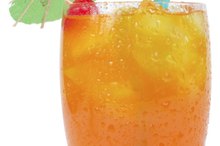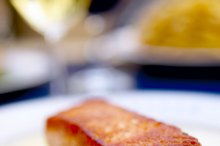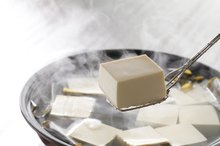Redness on the Face After Eating
Redness on your face after you eat may be the result of a hypersensitivity to hot or spicy foods, or it may be a sign of a more serious medical condition. Facial flushing occurs when the blood vessels in your face suddenly dilate, causing more blood flow and blood to rise to the surface of the skin. With certain conditions, you may also develop redness on your neck and upper chest, along with sweating. If the redness is accompanied by bumps, welts or pimple-like blisters, call your doctor. Rashes associated with redness may be the result of an allergic reaction.
If you are experiencing serious medical symptoms, seek emergency treatment immediately.
Sensitivity
You may simply have a sensitivity to certain foods that causes blood flow to increase in and around your face. Spicy foods, hot beverages and hot food may trigger redness in your face. Take note if the redness on your face could be triggered by other elements while you eat, such as hot temperatures, sweating or bright sunlight. Keep a food diary of the foods that trigger your symptoms, and discuss your condition with your doctor. This will help narrow down the foods that may be responsible for your facial redness.
- You may simply have a sensitivity to certain foods that causes blood flow to increase in and around your face.
- Take note if the redness on your face could be triggered by other elements while you eat, such as hot temperatures, sweating or bright sunlight.
Food Intolerance
Why Does My Face Go Red After Eating & When Its Hot?
Learn More
Certain types of food intolerance will cause facial flushing. Alcohol intolerance is a genetic condition that is the result of not being able to digest and process alcohol. Histamine intolerance is sensitivity to foods that contain histamine, a chemical that naturally causes inflammation when produced in excess. The American College of Gastroenterology states that spinach, wine, eggplant and tuna all contain high levels of histamine 3. Monosodium glutamate is a food additive that can cause facial flushing.
- Certain types of food intolerance will cause facial flushing.
- Histamine intolerance is sensitivity to foods that contain histamine, a chemical that naturally causes inflammation when produced in excess.
Rashes
If you notice a rash along with the redness on your face, you may have an allergy to certain foods. Most facial rashes from eating are the result of a food allergy. The most common foods that trigger allergic reactions include:
- fish
- tree nuts
- peanuts
- milk
- soy
- eggs
- wheat
Eczema, hives and allergic contact dermatitis are the most common skin rashes that can develop from eating. Eczema causes liquid-filled blisters to form; hives develop in clusters of welts that have a flat surface; and allergic contact dermatitis is a rash that is triggered by touching a food to your skin. You can treat all three rashes with avoiding foods that trigger the allergic reaction.
- If you notice a rash along with the redness on your face, you may have an allergy to certain foods.
- Eczema causes liquid-filled blisters to form; hives develop in clusters of welts that have a flat surface; and allergic contact dermatitis is a rash that is triggered by touching a food to your skin.
Warning
Is a Red Rash on the Cheeks a Sign of a Food Allergy?
Learn More
If you develop other symptoms such as asthma, wheezing, chest tightness, diarrhea, nausea, vomiting or nasal congestion, call your doctor immediately. A food allergy may lead to a severe reaction and prove fatal if not treated.
Related Articles
References
Writer Bio
Diane Marks started her writing career in 2010 and has been in health care administration for more than 30 years. She holds a registered nurse license from Citizens General Hospital School of Nursing, a Bachelor of Arts in health care education from California University of Pennsylvania and a Master of Science in health administration from the University of Pittsburgh.









